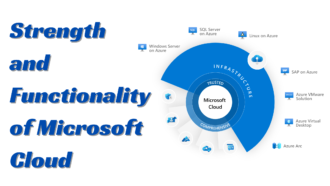Scale on Demand: Automating Tasks and Workflows with Azure SQL Database
Managing workloads and maintaining a healthy database can be time-consuming and error-prone. Fortunately, Azure SQL Database offers powerful automation tools that can help you streamline your operations and free up valuable resources. As a fully managed relational database service from Microsoft Azure, it provides features and tools for automating routine tasks and optimizing workflows.
This blog post explores various methods and best practices for automating tasks within Azure SQL Database, empowering you to boost productivity and focus on innovation.
Key features and benefits of Azure SQL Database
Azure SQL Database caters to diverse database management needs with many features and benefits. Here are some highlights:
Features:
- Fully Managed Service: Say goodbye to managing infrastructure and patching updates. Azure takes care of everything, freeing you to focus on core tasks.
- High Availability and Disaster Recovery: Built-in redundancy and geo-replication ensure data access even during outages, minimizing downtime and data loss.
- Scalability and Elasticity: Effortlessly adjust compute resources based on workloads, ensuring optimal performance without manual intervention.
- Security and Compliance: Benefit from robust security features like threat detection, data encryption, and compliance certifications for peace of mind.
- Global Reach: Deploy your database in your desired region for low latency and data residency requirements.
- Integration with Azure Ecosystem: Seamlessly integrate with other Azure services like Azure Logic Apps and Azure Functions for powerful workflows.
- Familiar Tools and Languages: Leverage your existing SQL Server knowledge and tools for a smooth transition.
Benefits:
- Reduced Costs: Eliminate hardware and infrastructure costs associated with on-premises databases.
- Increased Efficiency: Spend less time managing databases and more time innovating and developing.
- Improved Performance: Experience consistent and predictable performance with automatic scaling.
- Enhanced Security: Protect your data with comprehensive security measures and industry-leading compliance.
- Greater Agility: Easily adapt to changing business needs with flexible scaling and global reach.
- Simplified Management: Focus on strategic initiatives while Azure handles infrastructure management.
- Developer Productivity: Work with familiar tools and languages for faster development cycles.
- Innovation Opportunities: Integrate with other Azure services to unlock new possibilities and build data-driven solutions.
Managing and Monitoring Azure SQL Database
Effective management and monitoring are crucial for ensuring optimal performance, availability, and security of your database resources. Here’s a breakdown of managing and monitoring Azure SQL Database:
Managing Azure SQL Database:
Resource Provisioning and Configuration:
- Create and configure Azure SQL Database instances based on performance and storage requirements.
- Adjust resource configurations such as vCores, storage, and Database Transaction Units based on workload demands.
Database Administration:
- Perform routine tasks such as creating, deleting, and managing databases.
- Manage database users, roles, and permissions to control access to data and resources.
- Configure firewall rules to control inbound and outbound traffic to the database.
Backup and Restore:
- Set up automated backup policies to create regular backups of your databases.
- Configure long-term retention policies to retain backups for compliance and disaster recovery purposes.
- Perform point-in-time restores to recover databases to a specific moment in time.
High Availability and Disaster Recovery:
- Configure geo-replication to replicate databases across Azure regions for high availability and disaster recovery.
- Implement failover groups to automate failover between primary and secondary databases in case of regional failures.
Security and Compliance:
- Implement security best practices such as rest and transit encryption to protect sensitive data.
- Enable threat detection and auditing to monitor and respond to suspicious activities.
- Ensure compliance with industry regulations such as GDPR, HIPAA, and PCI DSS.
Performance Optimization:
- Monitor database performance using metrics and diagnostic logs.
- Analyze query performance and optimize query execution plans using tools like Query Store and Intelligent Insights.
- Implement indexing strategies to improve query performance and reduce resource consumption.
Monitoring Azure SQL Database
Metrics Monitoring:
- Monitor database performance metrics such as CPU usage, memory usage, storage utilization, and query throughput.
- Set up alerts to notify administrators of performance anomalies or threshold breaches.
Diagnostic Logging:
- Enable diagnostic logging to capture detailed information about database activities, errors, and resource utilization.
- Analyze diagnostic logs to troubleshoot issues, identify performance bottlenecks, and optimize resource usage.
Query Performance Monitoring:
- Use tools like Query Store and Query Performance Insights to monitor and analyze query performance over time.
- Identify and address long-running queries, high CPU queries, and other performance issues affecting database performance.
Security and Compliance Monitoring:
- Monitor security-related events such as login failures, data access, and database schema changes.
- Review audit logs and security alerts to detect and respond to potential security threats and compliance violations.
Automation and Remediation:
- Implement automation scripts and runbooks to perform routine maintenance tasks, such as index optimization, database backups, and failover testing.
- Configure automated responses to typical issues, such as scaling resources dynamically in response to increased workload demands.
Conclusion
In summary, Azure SQL Database’s automation capabilities empower organizations to scale on demand, automate tasks and workflows, and drive business success in today’s rapidly evolving digital landscape. By harnessing the power of automation, organizations can optimize resource utilization, minimize downtime, and accelerate innovation, ultimately gaining a competitive edge in the marketplace.
Therefore, adopting Azure SQL Database and leveraging its automation features can significantly benefit organizations of all sizes. However, we recommend you hire Azure developers with the expertise to unlock the platform’s full potential and realize these benefits.

















